-
Posts
6,486 -
Joined
-
Last visited
-
Days Won
10
Content Type
Profiles
Forums
Blogs
Gallery
Events
Store
Posts posted by Brian Wolfe
-
-
Hello Robin,
Thank you for the information. As I mentioned I had hoped that the photo was going to be clearer than it is. Internet photos and especially those on sites like eBay are not of the best quality at times.
I cannot be sure that the photo and the medals belong together. As you say there is no sign of a ribbon bar on the tunic in the photo and even if the photo was taken befor he received the Police Long Service Medal I would think he would have worn the Defence Medal ribbon. The dealer who sold me this (Buy It Now) has many other medal groups on eBay and his prices are far from being a bargan but the quality is always there. I've purchased from him before with no problems but never anything with a photo included. Other than a photo with a name tag or a purchase directly from the original recipient or even from the family one van never be sure that somewhere along the line someone has not enhanced the package by adding a photo, in this case of a police sergeant, to bump the collectability and therefore the value. I personally don't think that the dealer has done this but there is no proof that, even if I am correct, someone else added a bogus photo and then sold the group to him.
The seller states his location as "In beautiful Mount Rainier Country ~/~, United States" I'm sure eBay buyers have seen his many offerings.
When colleting police or any historic items one must always consider the evidence. If there is a reasonable doubt then one cannot make a statement of fact, as that is just not admissible in the antiquarian court. Also since I have the audacity to state that my blog is "News From the Home Office" the record must be accurate.
To this end this whole post will be placed in the file for future collectors who will end up with it after I have gone to that big medal show on the "other side".
In order to make sure the image of the medal pair is not accidently presented on the GMIC as a verified grouping I'll post the image here.
Thanks again,
Brian
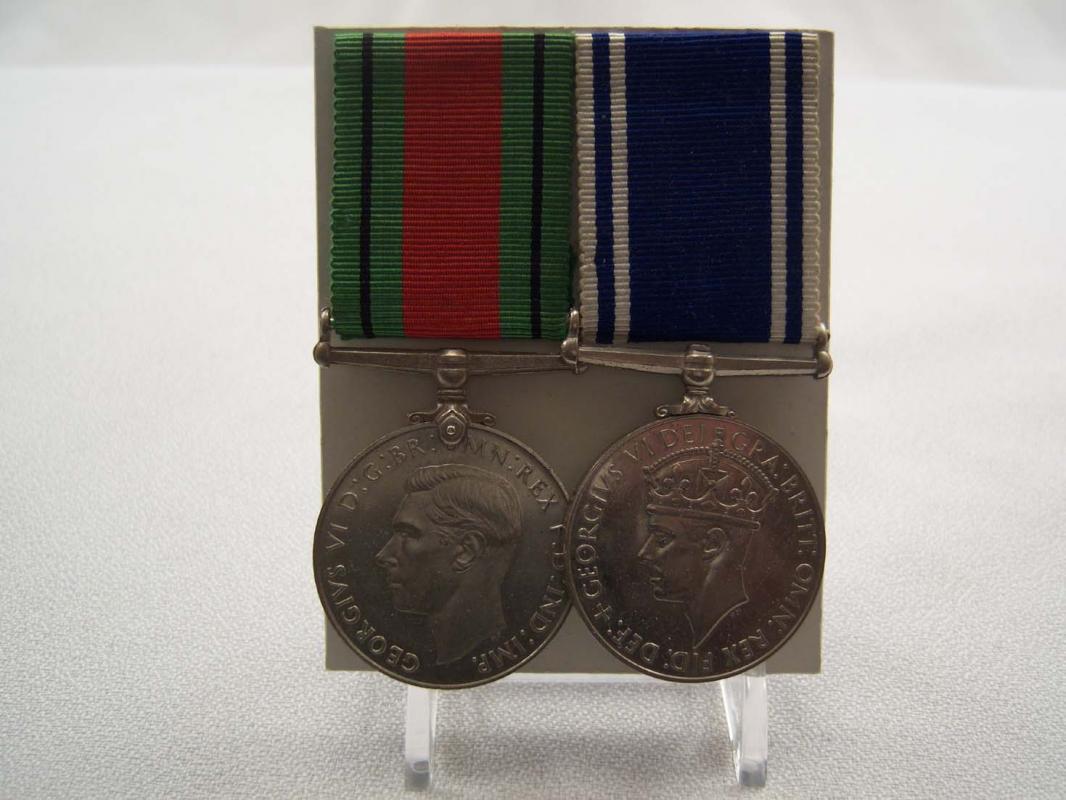
 0
0 -
Here are a couple of closer views of the hat badge and shoulder flash.
I'm sorry they are not clearer but this is as good as the original.
Why is it that anything police related is never easy?

Regards
Brian

 0
0 -
Hello Everyone,
It’s been a couple of months ago since I received this photo along with a pair of medals named to Sergeant T. Urquhart and this is the first time our lives have slowed down enough to start posting on the forum once again.
The question I have for my fellow collectors is what police service Sergeant Urquhart served with. When I purchased this group I was hoping that the photo was clearer than shown, however, that was not to be the case. The photos I have posted are as clear as the photo itself, sadly to say.
I am hoping that someone will recognize the hat badge from the shape and the general shading shown in the photo. Also there is a rather interesting shoulder flash that might give some clues. I don’t have a time period for the photo though the medals are the WWII Defence Medal and the Police Long Service Medal, so this may place the photo in the late 1950s or early 1960s. Once I discover the correct police service I will post the whole group.
Thanks in advance for any assistance you can give me, as always it is greatly appreciated.
Regards
Brian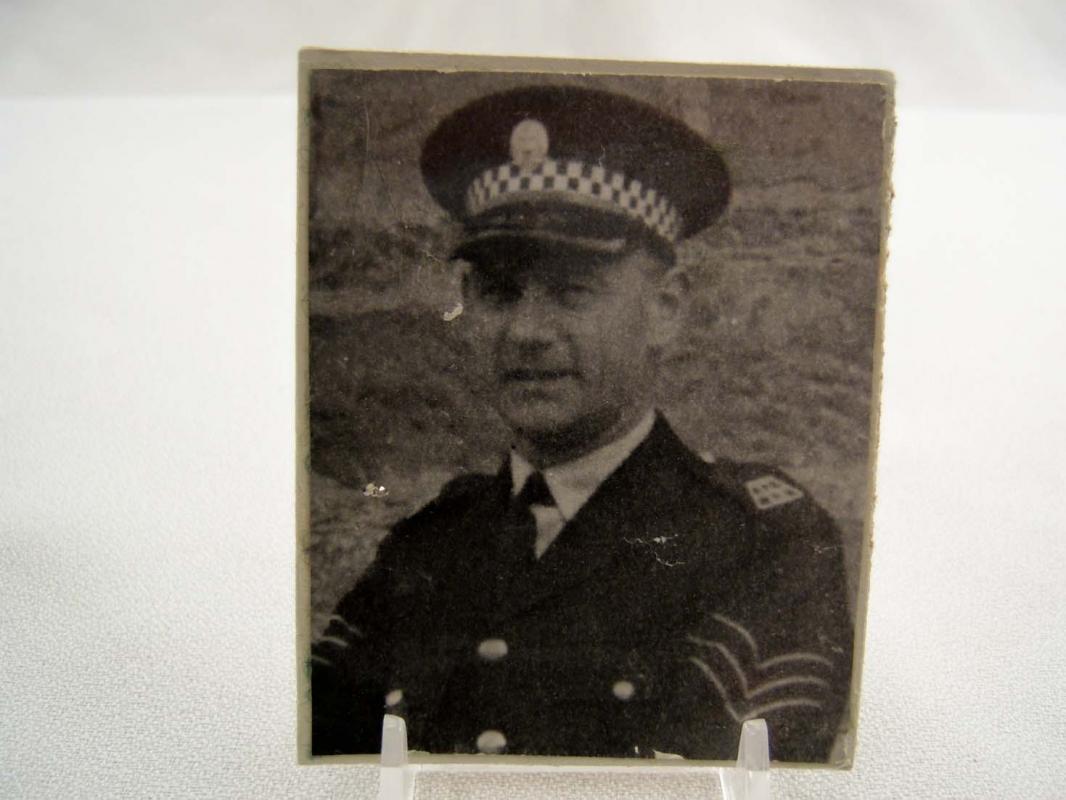 0
0 -
No probablem Craig, this could be a very useful reference with all of the white duty helmets in one place.
To kick this section off here is my Southend-on-Sea Constabulary helmet.
Regards
Brian
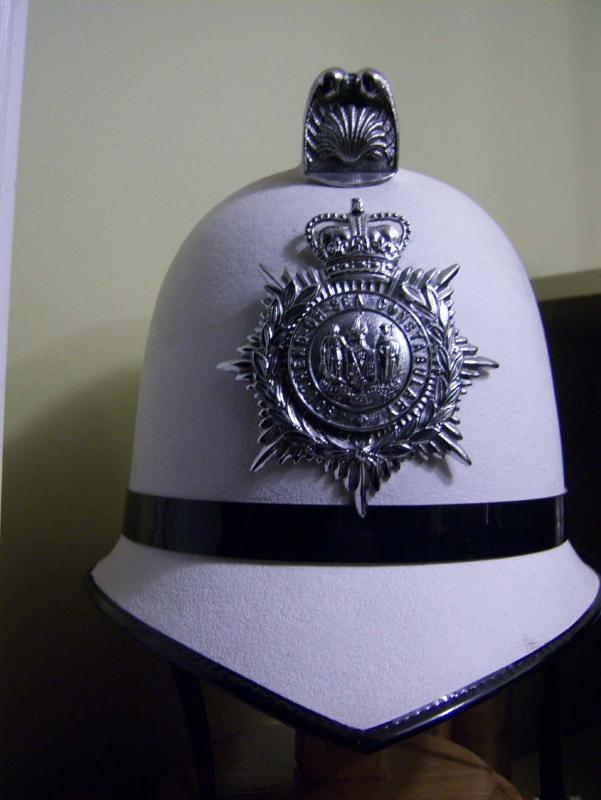 0
0 -
Hi Kelly,
I think you got a great deal indeed. There should be no problems with the way you are approaching the cleaning, these blades are fairly "forgiving".
Regarding your friend, yep, it seems to be an instinct to touch the blade. I used to feel rather foolish to hand someone white gloves to put on before they looked at one of my blades, but not any more. Since no one seems to be able to "look" with their eyes without touching it's wear the gloves or you get get to see my swords.
Well done Kelly and at a very sound price.
Regards
Brian
0 -
Just picked this up.
Always wanted one, for some strange reason.
Not a strange reason at all, I think they are beautiful. Now to get the rest of the "set".
Regards
Brian
0 -
Hello everyone,
Some new information has just come in from a new member, njaw (Nick) regarding this pistol.
I'll try to type his message to me word for word with as few typos as possible below.
"I just came across your post concerning the percussion pistol. A very nice piece indeed!
I have a pistol which is near enough identical to yours. Mine was actually used by the Merthyr Tydfil police force South Wales in the mid 1800's.
Your pistol sports a back lock action and was always a percussion pistol. It is not a flintlock conversion.
Despite what has been said in your thread, the pistol dates from the 1840's. The percussion system came into force in the 1830's as did the back lock action. Police pistols were often unsigned.
Cheers
Nick"
Nick provided me with a link to his collection and I must say I am impressed. I've asked if he would be interested in posting some of his collection and I do hope he will do so in the near future.
Many thanks Nick, this is exactly how a good forum becomes a great forum.
Regards
Brian
0 -
Thank you Mervyn,
This is important information and it is most appreciated.
Regards
Brian
0 -
Here is a view of the engraving on the butt and trigger guard as well as the name engraved on the top of the barrel.
From what I read these pistols were made by another company, inder the Manton Patent, after the financial failure of the Manton company. Therefore the date of manufacturer of this piece could be closer to the end of the era when dueling was considered proper.
Regards
Brian
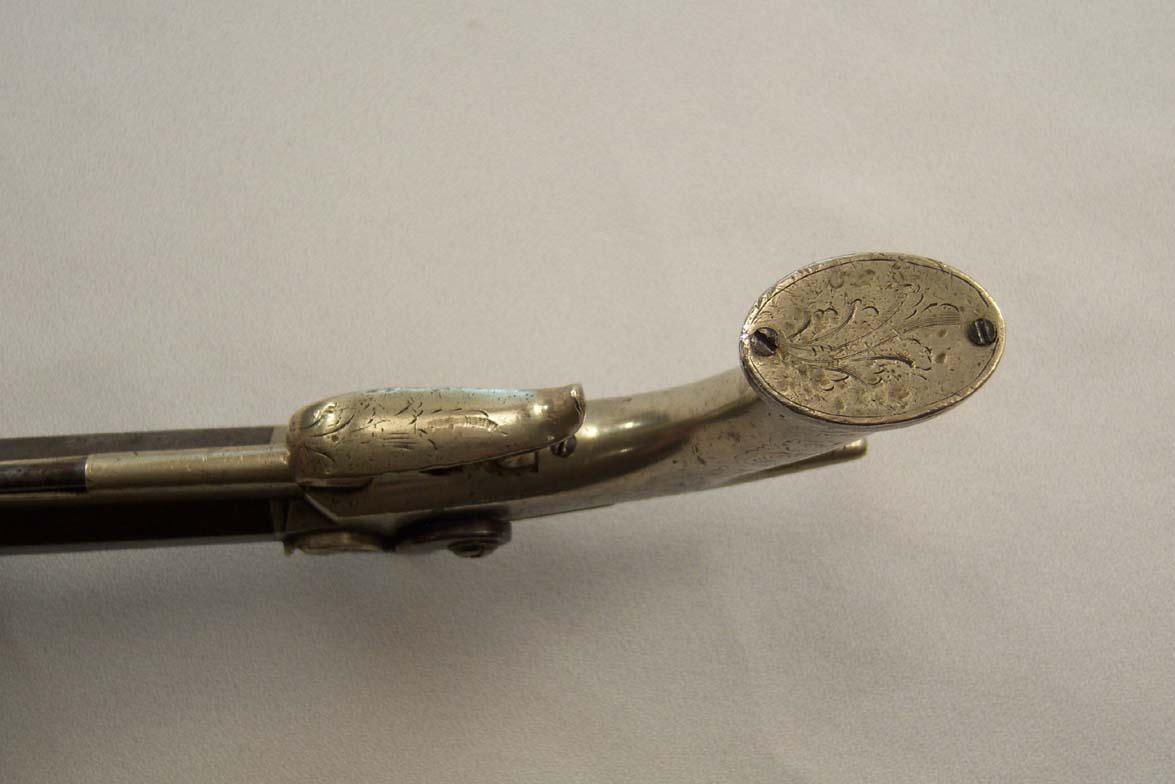
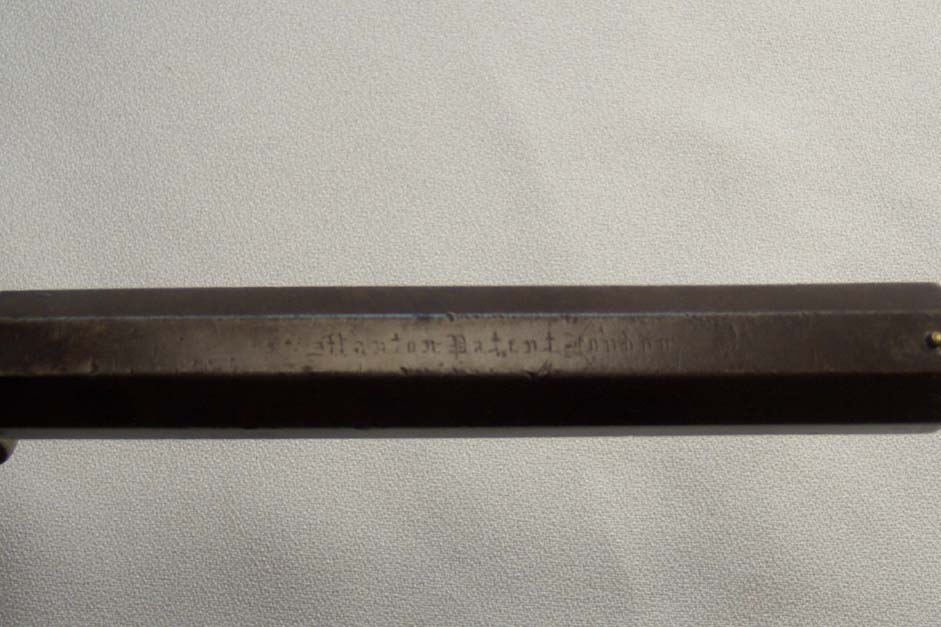 0
0 -
Joseph Manton – Dueling Pistol
In my resent blog I made mention of the dueling pistol I had purchased from a dealer at the Christies Antiques Show held twice a year at the Christie Conservation Area just outside of Hamilton Ontario. I thought I would show it here rather than with the blog so that all those interested in firearms might have a better chance to see it. The pistol is marked “Manton Patent London” on the top of the barrel. The handle is aluminum throwing the weight of the piece toward the barrel. The grip has a piece that protrudes backwards over the hand, causing this style to be called the “saw handle” grip. The trigger guard has a spur for the second finger of the hand which further helps to make this a very accurate and well controllable weapon. The total length of the pistol is 9½ (23½ cm.) inches with a ½ bore (12 mm). This particular pistol would have been made around 1830.
If you notice there seems to be a slight deflection of the barrel “downwards” as compared with the line of the grip. This is intentional to produce a pistol that has a more natural feel and pointing ability. That is to say, when you direct your hand toward the target the line of the barrel and therefore the shot is naturally horizontal with the ground so that you can hit what you are aiming at more easily. At the usual ten or twenty paces you don’t have a lot to worry about concerning bullet trajectory, there’s more to worry about with hitting the target altogether with these smooth bore pistols. There were some manufactures who produced a “scratch bore” pistol with the intention that is would be more accurate. As the name implies the bore was spirally scratched to produce a spin to the projectile. This never became popular and no serious duelist or proper gentleman would consider using a scratch bore dueling pistol as it was simply not sporting, old boy.
The hammer draw is quite light compared with the other black powder pistols both flintlock and percussion (which this one is) that one encounters. This specimen has what could only be considered a “hair trigger” as the slightest touch will set the firearm off. All of these features combine to make the perfect killing machine.
For more information on the interesting life of Joseph Manton I would suggest you take the time to check out the article on Wikipedia.
Regards
Brian
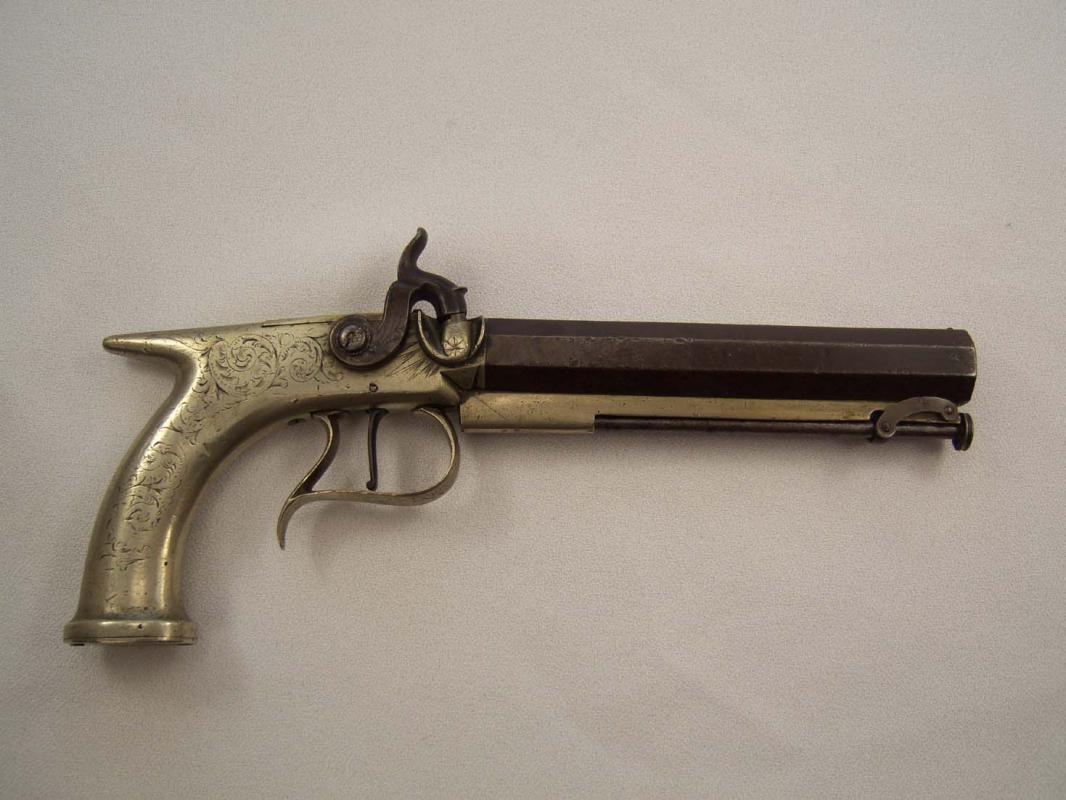
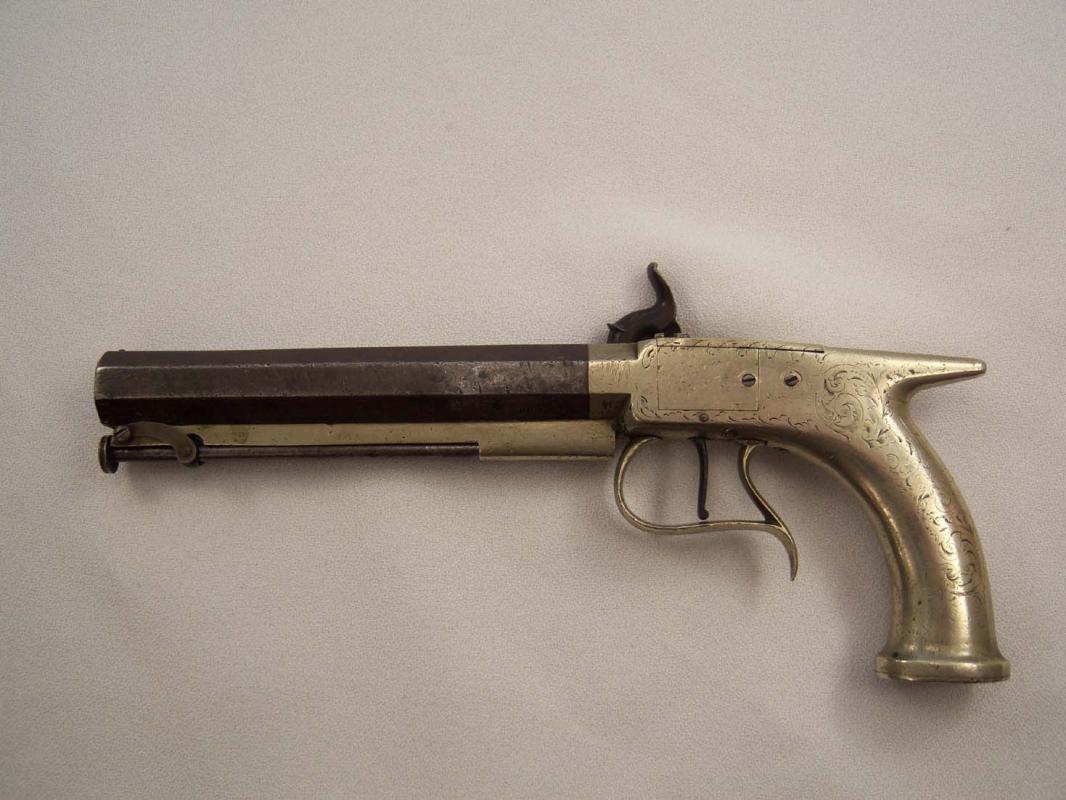 0
0 -
What can you do with these? wots a trivet?
Hi Chris,
I don't know if anyone fully answered your question or not but here goes.
They are used now a days under hot dishes or kettles to protect the surface, such as a table or counter top, from the direct heat. There were also used under old fashioned irons so the iron didn't burn the top of the ironing board. I didn't know about keeping the kettle boiling and I suspose one could place a votive candle under the kettle if the trivet were tall enough. Modern ones I've seen for sale are all too short for that use.
Regards
Brian
0 -
Oh Nick, that was hilarious.

Thank you for that one. LOL
Regards
Brian
0 -
Hi Claudius,
Irritating? I prefer the word "provocative" as it implies the potential to garner a positive response.
Sorry, but irritating, based on my time here would not really describe you well.
So, keep "irritating" us, we need prodding from time to time to make us think.
Regards
Brian
0 -
Whatever. Yours is the third highest of the four. Now, as before, you know more than before you posted the pic. A simple 'thanks' would be fine.
I guess I shouldn't even bother to post anything.
Please don't take that attitude, your posts are very valuable. Before this series of posts I thought there were only two varieties of these badges and I also assumed that they all came in wooden boxes. I know assumptions are the not in keeping with serious research, so I've once again been remind not to make them.
Other than this forum I have only "In the Name of a Living God" (Murphy & Ackley) and "Orders and Medals of Japan and Associated States" (Peterson) as reference material. Therefore, I thank the half dozen serious collectors of Japanese medals and badges on this forum for your assistance. By the way I see one glaring mistake in Peterson's book that I will bring up for discussion on another post at a later time to get your input so please do not be put off. Your participation is greatly appreciated.
Regards
Brian
0 -
Hello Everyone,
I'm posting my specimen of the Naval Funding Badge, which is one of the common examples. This one came in a wooden box and you can see the attachment loop sewen into the purple backing material to hold the badge in place.
Regards
Brian
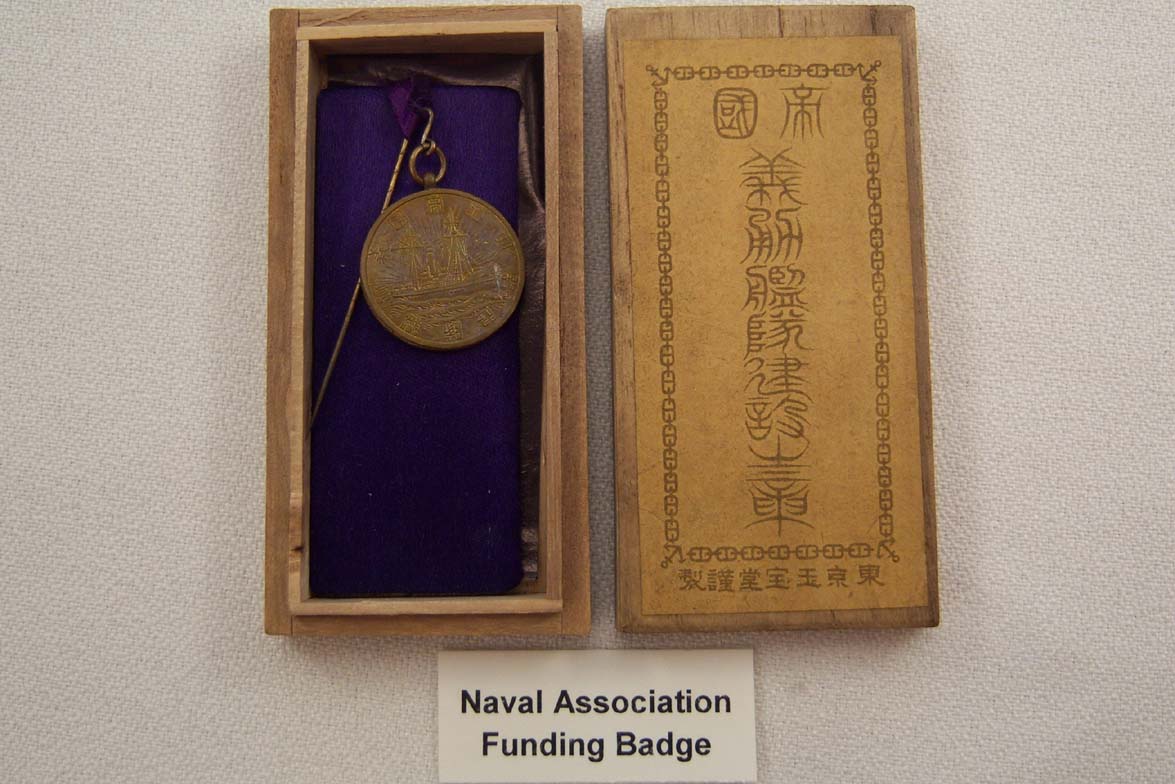 0
0 -
I would agree with Mervyn on both counts. Those who would have qualified for the Air Crew Europe medal but already were qualified for the Atlantic Star would have been awarded the Air Crew Europe clasp. This would have limited the number of Air Crew Europe Stars awarded. Though the same could be said for the Atlantic Star as it could have been awarded along witht he Air Crew Europe clasp.
It's always best if the paperwork is with any medal or group to support the clasp otherwise, as Mervyn said, "loose clasps fill me with suspicion".
Regards
Brian
0 -
I beleive this type of equipment had close connections to the military, or rather the navy, in many nations in the past and would be welcomed in other sections as well as this one.
I have always thought that the old diving helmets were well worth having in a collection and on this particular subject even my wife would agree.
Thank you for showing this to the membership and I highly recommend that anyone reading this post should also check out the link you have provided.
Regards
Brian
0 -
Some items in life are things of beauty and a joy to behold, these would fall under that catagory.
Thank you for sharing them with us.
Regards
Brian
0 -
That is a fantastic group indeed.... I assume France and germany and Burma are pretty rare when named to South Africans!
I would think so as well, Chris. It seems to me to be less common than someone with the Africa and/or Italy Star to have been sent off to fight against the Japanese. I do know it is more common to see an Indian group with the Africa and Italy Star along with the Burma but the European theater would have taken up much more time to complete.
It would be great to see mnore information of this officer's service.
Regards
Brian
0 -
Hello Anthony and welcome to the forum.
You have an interesting group of medals with an even more interesting story behind it. You should be every please to have such a group in your collection and thank you for sharing it with the members.
Even though the order is not correct, if this is the way the recipient had them then it is probably best to leave them in this order, at least in my opinion. Odd that they would be mounted as such though.
Regards
Brian
0 -
Hello Everyone,
While the order is incorrect there is a positive side to this. Throw-together groups are not considered a proper thing to do, among serious collectors. However, in this case years from now, this one is not likely going to be confused with an authentic group. It's always better to puchase a real group that has the ribbons in unsalvagable condition and then remount them. Even though the intent is to frame the above shown group as a "display only" it would be better to mount each one in a court mount style and display them as individual specimens in the same display frame and not as a mounted group.
Regards
Brian
0 -
Hello Moheb,
Welcome to the GMIC I hope the members can assist you with your questions.
Sorry that I can not help but I wanted to welcome your here anyway.
Regards
Brian
0 -
"Some may say it's only a pair to the R.A.but am please to think a group has been reunited."
In that case "some" would be fools.
Well done.
 Paul.
Paul.Regards
Brian
0 -
Hi Mervyn,
I agree with Brett.
This happened to a member of my own family.
As most things in life, it's all in the timing.
Regards
Brian
0




Dropped lucky
in Germany: Third Reich: Other Collectables: Standards, Allach Porcelain & Non Portable Awards
Posted
Those are the days to remember with fondness.
Congratulations.
Regards
Brian